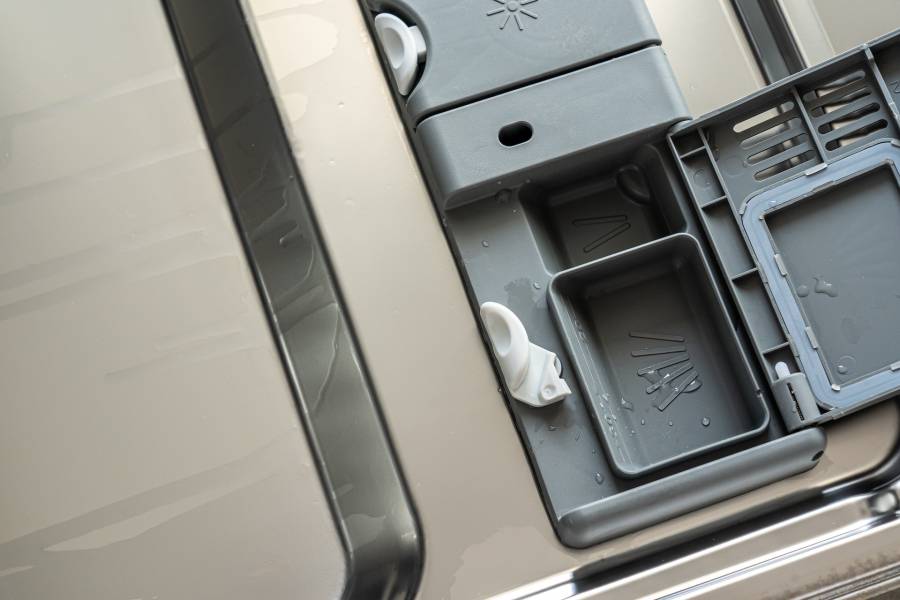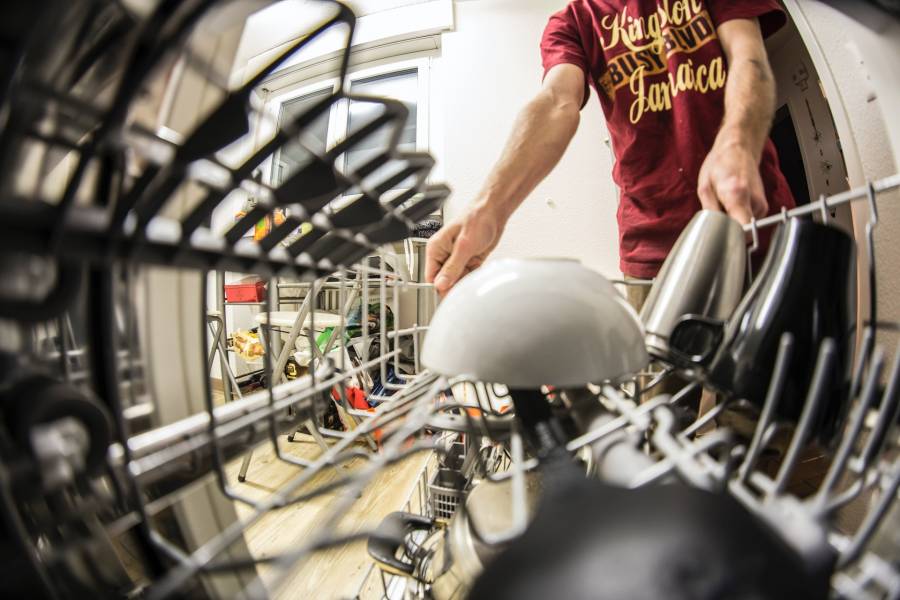Sometimes, after a complete cycle on the dishwasher, there might be spots on the dishes making them seem unclean.
Luckily, rinse aid ends the reign of dishwasher spots and slimy residue on your plates.

You can use rinse aid by filling the dispenser and running the dishwasher in two or three factory settings. Rinse aid reduces water surface tension in the dishwater, making it easier for the water to slide off plates.
It is beneficial if you have hard water with plenty of minerals since it prevents mineral deposits and water drops from lingering on your dishes.
So, if you are wondering how to use a rinse aid in the dishwasher, this article will guide you.
How To Use Rinse Aid In Dishwasher – Where To Put Rinse Aid In Dishwasher?
The rinse aid goes inside the dishwasher. Its compartment is next to the detergent.
Filling rinse aid is done manually, and the dishwasher releases it at the right time and temperature.
The rinse aid compartment uses a setting to determine the correct quantity and temperature for running the dishes. You’ll find the setting in the dishwasher user manual.
How Often Do I Fill the Rinse Aid In the Dishwasher?
How often you fill the rinse aid in your dishwasher depends on how often you wash plates. You can always add as needed, but we recommend refilling it monthly.
Some dishwashers have transparent compartments that let you see the quantity of the rinse aid. A dishwasher rinses aid dispenser has a 150ml quantity.
If you wash it sparsely, it will last up to three months without a refill. If it is a new dishwasher, it will need a rinse aid fill-up before use.
How To Use Rinse Aid In Dishwasher – Step-By-Step Procedure
Dishwashers have a rinse aid design to help in their drying. The option for dry heat does not work without a rinse aid, and the machine interior and dishes will end up retaining moisture.
With a rinse aid, the water slips off the plates, not cling.
Some dishwashers with energy conservation need to have rinse aids for optimal performance. This optimalism is why it is essential to fill the rinse aid in a dishwasher appropriately.
Here is how to use a rinse aid in a dishwasher:
- Press the rinse aid dispenser latch and pull open the lid.
- Pour the rinse aid liquid into the dispenser carefully till the top line. Ensure that you do not overfill the compartment to avoid leaking.
- Gently close the lid and ensure there is a lock click. The compartment might not be sealed appropriately without the click, and the rinse aid could leak into other chambers.
- Wipe off excess spillage around the dishwasher with a towel.
- Adjust the factory settings if you do not have a controlled environment on the rinse aid compartment.
- The best factory settings for rinse aid are two or three. But, if the dishwasher has drying issues, you can set it at the highest.
- Set by removing the knob on the dispenser and adjusting the arrow inside to any number you want. Then replace the knob.
- You can monitor and adjust the setting till you get the best for your dishwasher type.
- If you set it correctly, the rinse aid will dispense during the final cycle.
Ensure to fill a new dishwasher with a rinse aid before use. A full rinse aid dispenser should last up to a month with constant use.
It is best to use a bright color rinse aid like blue. Brilliant color rinse aid makes it easier to see the rinse gauge level.
Seeing Water Spots After Using Rinse Aid: What To Do?
If you still see water spots or slime on your dishes after using the rinse aid, there is no need to panic. It might be that the dispenser settings are wrong.
The dishwasher manual should show the correct setting number.
You can increase the setting number and run the dish to see if the water spotting continues. It might take some run cycles to get the right setting for your dishwasher, but you will get it.

Sometimes, it might be that the detergent is the cause of water spotting and cloudiness. Consider changing the brand of detergent you use.
Also, check for rinse aid residue inside the dishwasher. There might be an over-spillage.
Remove the bottle cap before filling to avoid spillage when pouring the rinse aid into its dispenser. And run from the compartment side.
Proper knowledge of using a rinse aid in a dishwasher will prevent the stress that comes with dishwater spotting.
Using Rinse Aid As A Detergent In The Dishwasher – Good Or Bad?
No, rinse aid is not a detergent. You can not use a rinse aid as a detergent in a dishwasher.
It does not play the same role and is not good. A detergent produces soapy foams that help wash off the dirt and oily content of the plates.
But, rinse aid breaks down the water tension and makes moisture sliding off the dishes easier.
Generally, rinse aid makes for better drying capacity in dishwashers. The detergent compartment is next to the rinse aid.
Both rinse aid and detergent make precise, clean, and sparkly dishes. Knowing how to use a rinse aid in a dishwasher is vital to avoid making silly mistakes.
Rinse Aid – All-In-One Washing Tablet – Salt For Dishwasher
Salt is a softening agent that softens hard water. But, the rinse aid breaks the water surface tension for easy water movement off the dishes.
If you are in a hard water area, you will need both salt and rinse aid for a dishwasher. But with an all-in-one tablet, there is no need for one of them.
You get water softening, cleaning, and rinsing properties in the tablet. Therefore, they will be no use for the salt and the rinse aid products.
Why Should I Use A Rinse Aid?
You should use a rinse aid product because of its sparkly drying quality. It ensures that your dishes are spot free and stays shining.
You can skip the rinse aid if you want. It is your dishwasher, so do what makes you comfy.
But, knowing how to use rinse aid in the dishwasher is a good skill.
You can use vinegar if you do not have or want to use a rinse aid. Vinegar has water surface tension-breaking properties and will give the same results as the rinse aid.
However, vinegar has a high acidity level that will damage the dishwasher parts. Using vinegar instead of rinse aid, you should use the dishwasher’s hottest cycle.
Conclusion
Rinse aid plays a huge role in the use of a dishwasher. Though it is not a must to use a rinse aid, it is a big necessity if you must have sparkling dishes.
They ensure that water slips off the platers and does not dry on them in spots, clouds, or slime.
The rinse aid goes into a separate room from the detergent and needs a factory set to work efficiently. This article has given a complete guide on using rinse aid in the dishwasher.



